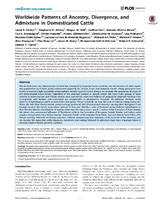Mostrar el registro sencillo del ítem
Worldwide Patterns of Ancestry, Divergence, and Admixture in Domesticated Cattle
| dc.contributor.author | Decker, Jared E. | |
| dc.contributor.author | McKay, Stephanie D. | |
| dc.contributor.author | Rolf, Megan M. | |
| dc.contributor.author | Kim, JaeWoo | |
| dc.contributor.author | Molina Alcalá, Antonio | |
| dc.contributor.author | Sonstegard, Tad S. | |
| dc.contributor.author | Hanotte, Olivier | |
| dc.contributor.author | Götherström, Anders | |
| dc.contributor.author | Seabury, Christopher M. | |
| dc.contributor.author | Praharani, Lisa | |
| dc.contributor.author | Babar, Masroor Ellahi | |
| dc.contributor.author | Correia de Almeida Regitano, Luciana | |
| dc.contributor.author | Yildiz, Mehmet Ali | |
| dc.contributor.author | Heaton, Michael P. | |
| dc.contributor.author | Liu, Wan-Sheng | |
| dc.contributor.author | Lei, Chu-Zhao | |
| dc.contributor.author | Reecy, James M. | |
| dc.contributor.author | Saif-Ur-Rehman, Muhammad | |
| dc.contributor.author | Schnabel, Robert D. | |
| dc.contributor.author | Taylor, Jeremy F. | |
| dc.date.accessioned | 2017-11-30T12:49:51Z | |
| dc.date.available | 2017-11-30T12:49:51Z | |
| dc.date.issued | 2014 | |
| dc.identifier.uri | http://hdl.handle.net/10396/15604 | |
| dc.description.abstract | The domestication and development of cattle has considerably impacted human societies, but the histories of cattle breeds and populations have been poorly understood especially for African, Asian, and American breeds. Using genotypes from 43,043 autosomal single nucleotide polymorphism markers scored in 1,543 animals, we evaluate the population structure of 134 domesticated bovid breeds. Regardless of the analytical method or sample subset, the three major groups of Asian indicine, Eurasian taurine, and African taurine were consistently observed. Patterns of geographic dispersal resulting from co-migration with humans and exportation are recognizable in phylogenetic networks. All analytical methods reveal patterns of hybridization which occurred after divergence. Using 19 breeds, we map the cline of indicine introgression into Africa. We infer that African taurine possess a large portion of wild African auroch ancestry, causing their divergence from Eurasian taurine. We detect exportation patterns in Asia and identify a cline of Eurasian taurine/indicine hybridization in Asia. We also identify the influence of species other than Bos taurus taurus and B. t. indicus in the formation of Asian breeds. We detect the pronounced influence of Shorthorn cattle in the formation of European breeds. Iberian and Italian cattle possess introgression from African taurine. American Criollo cattle originate from Iberia, and not directly from Africa with African ancestry inherited via Iberian ancestors. Indicine introgression into American cattle occurred in the Americas, and not Europe. We argue that cattle migration, movement and trading followed by admixture have been important forces in shaping modern bovine genomic variation. | es_ES |
| dc.format.mimetype | application/pdf | es_ES |
| dc.language.iso | eng | es_ES |
| dc.publisher | Public Library of Science | es_ES |
| dc.rights | https://creativecommons.org/licenses/by-nc-nd/4.0/ | es_ES |
| dc.source | PLoS Genet 10(3): e1004254 (2014) | es_ES |
| dc.subject | Cattle | es_ES |
| dc.subject | Domestic animals | es_ES |
| dc.subject | Introgression | es_ES |
| dc.subject | Phylogenetic analysis | es_ES |
| dc.subject | Europe | es_ES |
| dc.subject | Africa | es_ES |
| dc.subject | Phylogenetics | es_ES |
| dc.subject | Covariance | es_ES |
| dc.title | Worldwide Patterns of Ancestry, Divergence, and Admixture in Domesticated Cattle | es_ES |
| dc.type | info:eu-repo/semantics/article | es_ES |
| dc.relation.publisherversion | http://dx.doi.org/10.1371/journal.pgen.1004254 | es_ES |
| dc.rights.accessRights | info:eu-repo/semantics/openAccess | es_ES |

